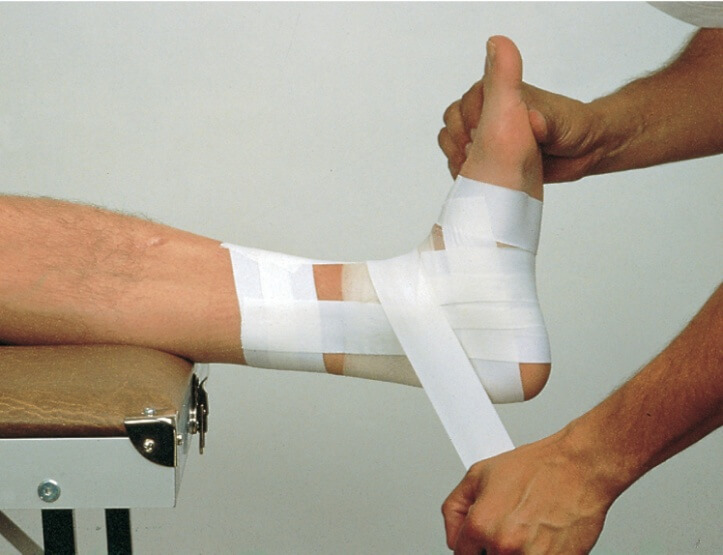Around a quarter of all musculoskeletal injuries are ankle inversion sprains, with up to 5000 happening in the UK every day (Kannus P et al, 1991). If you’ve ‘”rolled” your ankle you are definitely not alone.
Around 95% of these injures can be resolved in approximately 6 weeks with a directed exercise and a functional rehabilitation program (Doherty C et al, 2016). These are the top 5 physio tools to help you get back onto the court or the pitch as nimble as ever.
The prime stability of most joints usually comes from the bony structure and neighbouring tendons. However at the highly flexible ankle, the surrounding muscles are also hugely responsible for locking the foot in place when landing or pushing sideways.
The group of muscles on the outside of the ankle and calf, the peroneus muscles, are the prime dynamic stabilisers of the ankle. When you land on the outside border of your foot, these are the muscles which are injured by being forcibly stretched.
By strengthening these muscles, they are more suited to be able to deal with the forces they’re put under during the explosive movements. With these muscles primed for intense exercise, it will improve the stability of the ankle and make them more resilient to repeat injury.
The most common action when rolling an ankle is landing on one foot, either during running diagonally or descending from a jump (Doherty C et al, 2016). If you land primarily on the outside edge of the foot, you risk of the foot rolling inward. By retraining these movement patterns and re-educating your landing technique on a neutral foot position, you can significantly reduce your risk of reoccurrence.
One of the best ways to retrain these muscles is by challenging your balance using equipment such as a Bosu Ball while performing hopping or landing actions, or even during sport specific actions (i.e. landing on a single foot after a serve).
You can also identify and correct foot posture during these activities by analysing slow motion video.
Read our article about balance
Sometimes rolling the ankle can be a freak accident e.g. tripping over your feet when racing to the baseline. However, if this happening regularly, there could be another hidden cause.
The ankle is hugely influenced by the movement of the knee and hip, so it is imperative to identify any movement issues with these too. That’s why we’ll assess your whole limb. Hip and knee instability during running or lateral cutting can put tremendous strain on the ankle. And if the larger muscles are firing inefficiently, your ankle could be working overtime to compensate.

Strapping and taping can be a little controversial, but used alongside rehabilitation they can reduce the risk of re-injury in the early stages. By giving some proprioceptive feedback to the ankle, as well as some additional support, strapping can improve stability and the landing pattern as described above.
Tape, however, is not going to solve an issue, merely patch it up temporarily. Rehabilitation still needs to be the forefront of your plan, particularly as individuals can become reliant on tape both physically and psychologically prior to activity and sport.
There is some risk of skin irritation when using certain types of tape, and if the tape is applied incorrectly or inefficiently, it can lose its effectiveness in as little as 200 steps (Best R et al, 2014).

Where taping can be time consuming, and often difficult to apply on your own, a good alternative for a chronic ankle instability would be bracing. Braces don’t require particular training to apply, and can work out significantly cheaper if you have a recurrent injury (Olmsted et al, 2004).
One of the most popular braces currently is the Aircast A60 Brace, often called the ‘Andy Murray Brace’. Similar to taping, the body and mind can become reliant on these supportive accessories, meaning the muscle firing patterns and structural stability don’t return to their pre-injured level. They should be used only as a tool to return to activity quicker, not as a new essential piece of kit for the foreseeable future.
So there we have it – the top 5 strategies in the physio’s ankle inversion tool kit:
Read our article in Sebra News W2 on optimising your recovery.
Sell K, Hainline B, Yorio M, Kovacs M – Injury trend analysis from the US Open Tennis Championships between 1994 and 2009; BJSM 2014; 48(7):546-551.
Kannus P, Rentrom P - Treatment for acute tears of the lateral ligaments of the ankle; J Bone Joint Surg Am 1991; 73(2):305-312.
Doherty C, Bleakley C, Hertel J, et al - Recovery from a first-time lateral ankle sprain and the predictors of Chronic Ankle instability; AJSM 2016: 44(4):995-1003.
Best R, Mauch F, Bohle C, et al - Residual Mechanical effectiveness of external tape before and after competitive professional soccer performance; Clin J Sports Med 2014: 24(1):51-57.
Olmsted L, Vela L, Denegar C, Hertel J - Prophylactic Ankle Taping and Bracing: A Cost-Benefit analysis; J Athl Train 2004: 39(1):95-100.